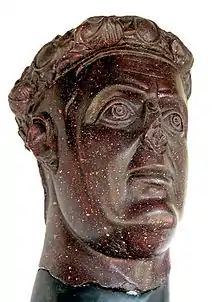伽列里乌斯
伽列里乌斯,全名盖乌斯·伽列里乌斯·瓦列里乌斯·马克西米安努斯(Gaius Galerius Valerius Maximianus ,约260年-311年),罗马帝国皇帝戴克里先的女婿,後亦為罗马帝国皇帝,公元305年-311年在位。出生在今天塞尔维亚的加姆济格勒-罗慕利亚纳地方。后来他在这里建筑了自己的皇宫,他的皇宫遗迹在2007年被列为世界文化遗产。
| 伽列里乌斯 Galerius | |||||
|---|---|---|---|---|---|
 Porphyry bust of Galerius | |||||
| 罗马帝国東部皇帝 | |||||
| 統治 | 293年3月1日或5月21日[1][2]:4, 38[3]:288[4]:146[5]:64–5[6] – 1 May 305 (as Caesar, under Diocletian)[7] 1 May 305 – late April or early May 311 (as Augustus alongside Constantius (until July 25, 306) then Severus (until spring 307) then Constantine (from ca. September 307; unrecognized by Galerius' coinage from ca. September 307 to November 308) then Licinius (from 11 November 308))[2]:4–6 | ||||
| 前任 | 马克西米安、戴克里先[7] | ||||
| 繼任 | 马克西米努斯、君士坦丁一世、李锡尼[2]:7 | ||||
| 出生 | 约260年[2]:37, 46 塞尔迪卡(今保加利亞的索菲亚)[8] | ||||
| 逝世 | 311年4-5月间 (51岁)[9] 塞尔迪卡(今保加利亞的索菲亚) | ||||
| 安葬 | |||||
| 配偶 | Galeria Valeria[2]:38 | ||||
| 子嗣 | Candidianus Valeria Maximilla, Roman Empress | ||||
| |||||
| 母親 | Romula (alleged)[2]:37–8 | ||||
生平
据说伽列里乌斯早年是一个牧人。后来参加军队,曾经在皇帝奥勒良和普罗布斯的军队中充当一名士兵。后来被戴克里先提拔。戴克里先设立四帝共治制度,自己和马克西米安分别为东部和西部的皇帝,同时,又设立“凯撒”一职,作为副皇帝。293年,伽列里乌斯被提拔为戴克里先的凯撒,而君士坦提乌斯一世则被立为马克西米安的凯撒。为了加强关系,伽列里乌斯娶戴克里先的女儿为妻。
作为副皇帝的伽列里乌斯,很快就卷入了对波斯的战争,战争从296年打到297年,罗马获得全胜,彻底改变了自瓦莱里安被俘以来的东方的局面。303年羅馬皇宮火災,伽列里乌斯歸咎於基督徒,導致戴克里先開始羅馬帝國最後也最大的迫害基督教運動。
305年,戴克里先和马克西米安同时退位,而伽列里乌斯和君士坦提乌斯一世同时升为羅馬東、西部的“奥古斯都”。但是,戴克里先的退位,却很快引起了新的纷争。伽列里乌斯自认为是羅馬帝國最高皇帝,所以他选择自己的外甥马克西米努斯和自己家里的一个家臣塞维鲁(即塞维鲁二世)充当东部和西部的“凯撒”,而完全不顾马克西米安和君士坦提乌斯一世在西部的势力,以及这两位都有了成年的儿子。
306年,君士坦提乌斯一世在不列颠去世,其子君士坦丁一世迅速出兵,控制了不列颠和高卢地区。在约克,军队拥立君士坦丁一世为西部奧古斯都,後來君士坦丁接受伽列里烏斯之命改任西部凱撒。在罗马城,人民不满伽列里乌斯所指派的塞维鲁二世升任西部奧古斯都,拥立马克西米安的儿子马克森提乌斯为帝。同时,为了帮助自己的儿子,马克西米安也复出称帝。塞维鲁二世率军进入意大利,结果却被马克森提乌斯打败,被俘。307年,伽列里乌斯为此,率军进入意大利,烧杀抢掠一番后,却无法占领意大利,只好退兵。
因为塞维鲁二世被杀,伽列里乌斯又在308年提拔李锡尼为羅馬西部的奥古斯都。这让马克西米努斯非常不满,于是向伽列里乌斯通报,说自己已经被军队擁立为奥古斯都,於是造成罗马帝国在308年一度同时有六个奧古斯都的景象。不过伽列里乌斯在世时,李锡尼和马克西米努斯尚保持着和平。
311年伽列里烏斯重病,痛苦萬分,四月頒佈寬容詔諭(edict of toleration),要求基督徒為他的重病禱告,然而六天後他還是不治去世。他死后,李锡尼和马克西米努斯迅速决裂。
參考資料
- Barnes, Constantine and Eusebius, pp. 8–9.
- Barnes, .
- Potter, .
- Southern, .
- Williams, .
- The earlier dates for Galerius' appointment have been argued for based on the suggestion that the appointments of Constantius and Galerius were timed to coincide (Barnes 1981, 8–9; Southern 1999, 146). Barnes (1982, 62) argues against a dating of 21 May 293 in Nicomedia originating in Seston, Dioclétien, 88ff., stating that the evidence adduced (the Paschal Chronicle 521 = Chronica Minora 1.229 and Lactantius, DMP 19.2) is invalid and confused. Lactantius is commenting on Diocletian and the place where Diocletian was acclaimed, and that the "Maximianus" in the text is therefore a later gloss; the Paschal Chronicle is not authoritative for this period for events outside Egypt, and may simply be commenting on the day when the laureled image of the new emperors arrived in Alexandria. Potter (2004, 650) agrees that locating the acclamation to Nicomedia is false, but believes that Seston's other evidence makes a strong case for a temporal lag between the two Caesars' acclamations.
- Barnes, New Empire, p. 4.
- Eutropius. Breviarivm historiae romanae, IX, 22 页面存档备份,存于 Template:Ref-la
- Lactantius, DMP 35.4. The exact date is lost in a lacuna (Barnes 1982, 6).
